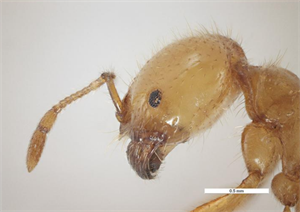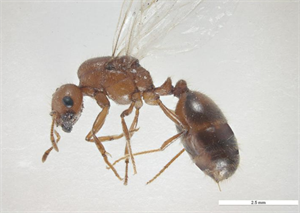Tropical fire ant, tropical red fire ant, ginger ant, red ant.
Pacific Pests, Pathogens and Weeds - Online edition
Pacific Pests, Pathogens & Weeds
Tropical fire ant (362)
Solenopsis geminata
Asia, Africa, North, South and Central America, the Caribbean, Oceania. It is recorded from Australia (restricted), American Samoa, Cook Islands, Federated States of Micronesia, Fiji, French Polynesia, Guam, Kiribati, Marshall Islands, New Caledonia, Northern Mariana Islands, Papua New Guinea, Samoa, Solomon Islands, Tonga, and Vanuatu.
A ground-nesting ant that makes nests in a variety of disturbed, mostly sunny places, in agricultural areas, natural and planted forests, grasslands, as well as urban localities. Seeds are taken from cabbages, maize, sorghum, tomato, wild grasses, and weeds.
An aggressive, invasive ant with a painful sting that often dominates where introduced.
Tropical fire ants are orange to reddish brown; workers are of different sizes, 3-6 mm long. There are two kinds of workers: 'minor (Photos 1&2) and 'major' (Photo 2&3). The heads of both are squarish, but those of 'major' workers are unusually large in proportion to the rest of their bodies). The functions of these workers change during their lives from early care of the brood and queens, guarding the nest, retrieving food, foraging and laying chemical trails. Overall, this ant is similar to the red imported fire ant (see Fact Sheet no.363), except the latter is more aggressive and the stings are more painful.
Nests are slightly raised mounds of soil with several entrance holes. They are usually made in open, disturbed areas. Below ground, foraging tunnels radiate in all directions for several metres just below the surface, with some descending vertically for a metre or more. Nests are of two kinds: one type has a single queen, the other has several. Where there are more than one queen there is no territorial behaviour and the number of mounds may be 10 times more than if nests had single queens.
Food is varied. Seeds are collected, stored and used after milling by the major workers. Honeydew from aphids, scale insects, mealybugs and whiteflies is collected, and other insects, and small vertebrates are predated. Foraging is usually within 15 m of the nest.
Spread occurs by fertile queens establishing a new nest following a mating flight, or it occurs by 'budding'. Budding is more common where there are several queens in a nest - a queen (Photo 5) will move out with a few workers and establish a nest nearby; spread by mating flights is more common where there are single queens; in this case, a new queen will fly up to 2 km from its original nest. Spread also occurs over long distances in the soil of potted plants.
Solenopsis geminata is known as a 'tramp' ant. These are ants that have become widely distributed globally associated with increased trade and commerce. Introductions have agricultural, social and environmental impacts, although the economic consequences are rarely stated.
Stings are painful, the itch lasting several days, deterring workers from fields where ants are present. Seed losses may be considerable (substantial losses involving tomato are reported), and damage to agricultural equipment occurs, e.g., to irrigation hoses, in particular. The protection of sap-sucking insects from their natural enemies encourages population explosions of pest species. There are also losses of biodiversity with reports of the tropical fire ant killing hatchling turtles, and eating eggs of birds, reptiles and amphibians.
Look for reddish-brown ants with brown heads, and for the major workers with their large heads; separation to species needs the assistance of a taxonomist familiar with the megacephala group.
The PIAkey provides charts with three similar Solenopsis species - geminata, invicta and papuana, plus Monmorium species - side-by-side for comparisons of important taxonomic features. (http://idtools.org/id/ants/pia/Fact_Sheets/Solenopsis_geminata.html). The feature on the head that distinguishes geminata from invicta is shown.
The app: Antkey Mobile: an identification key for introduced ants. USDA. LUCID, is useful for preliminary examinations, as is the online version: (http://idtools.org/id/ants/pia/PIAkey_v2.html).
The Pacific Invasive Ants Taxonomy Workshop manual has a key to the Pacific species and is well illustrated (http://www.issg.org/cii/Electronic%20references/pii/project_docs/papp/pacific_ants_taxonomy_workshop_2009.pdf).
QUARANTINE
Countries that are still free from, but vulnerable to the tropical fire ant, need to: (i) define the risk; (ii) have preventive measures in place against an introduction; (iii) have quarantine protocols enacted in case a breach occurs; and (iv) be able to carry out a rapid response against this ant and others. It is important to have rapid response procedures in place in case eradication is a possibility. In addition, it is necessary to have biosecurity regulations to prevent movement of the ant within the country, especially in Pacific island countries where most are island groups or archipelagos. Finally, monitoring is required on the islands still free from infestation.
A Pacific Ant Prevention Plan has been written on behalf of the IUCN/SSC Invasive Species Specialist Group and presented to the Pacific Plant Protection Organisation and Regional Technical Meeting for Plant Protection (2004). Solenopsis geminata is one of the 11 species covered. (http://issg.org/database/species/reference_files/PAPP.pdf). The Plan focuses on ways to prevent the introduction, establishment and spread of this ant.
Guidelines to assist Pacific island countries and territories in planning effective management of invasive species have also been prepared by the Pacific Community and the Secretariat of the Pacific Regional Environment Programme. (http://www.piat.org.nz/uploads/PIAT_content/pdfs/SPREP%20guidelines%20for%20invasive%20species%20management%20in%20the%20Pacific.pdf).
The IUCN/SSC Invasive Species Specialist Group website should be consulted for details on all aspects of eradication and management of invasive ants (http://www.issg.org/).
CULTURAL CONTROL
Hot water at 47°C (and above) kills ants. Hot water up to 49°C will not damage plants. A more extreme method is to use fire to destroy the nests and to create conditions that favour native ant species.
CHEMICAL CONTROL
In general, three types of chemicals are used against ants: (i) stomach poisons. e.g., Maxforce® (fipronil), Amdro® (hydramethylnon), and borax; (ii) insect growth regulators (e.g., Engage® (methoprene), and Distance® (pyriproxyfen); and (iii) poisons that work on the nervous system, that is, neurotoxins, e.g., bifenthrin, fipronil, and imidacloprid. Stomach poisons kill all queens, intercastes and workers; insect growth regulators stop the queens from laying eggs, whereas neurotoxins disrupt insects' central nervous system. It is likely that future products will combine toxins that cause rapid death and insect growth regulators, e.g., Extinguish Plus® (hydramethylnon and methoprene).
A note of caution: Although it is possible to combine a lure (such as peanut butter, fish, sugar, etc.) with a pesticide as an ant bait, it is not recommended because of the danger in leaving concentrated pesticides unattended in the environment, including dwellings.
The eradication of the tropical fire ant in Kakadu National Park, Australia (using hydramethylnon and diazinon), is a case study in the Pacific Invasive Ant Toolkit: (http://www.piat.org.nz/getting-rid-of-ants/management-case-studies/tropical-fire-ant-management-case-study). See also treatment options in the Pacific Invasive Ant Toolkit under (http://piat.org.nz/getting-rid-of-ants).
____________________
When using a pesticide, always wear protective clothing and follow the instructions on the product label, such as dosage, timing of application, and pre-harvest interval. Recommendations will vary with the crop and system of cultivation. Expert advice on the most appropriate pesticide to use should always be sought from local agricultural authorities.
AUTHOR Grahame Jackson
Information from CABI (2017) Solenopsis geminata (tropical fire ant). Crop Protection Compendium. (https://www.cabi.org/cpc/datasheet/50568); and Pacific Invasive Ant Toolkit. (http://piat.org.nz/index.php?page=tropical-fire-ant); and Selonopsis geminata. AntWiki. (http://www.antwiki.org/wiki/Solenopsis_geminata); and AntWeb. (https://www.antweb.org/description.do?genus=solenopsis&species=geminata&rank=species); and from Solenopsis geminata (2018) Global Invasive Species Database.(http://www.iucngisd.org/gisd/speciesname/Solenopsis+geminata). Photo 1 Simon Hinkley & Ken Walker (2001) Tropical fire ant (Solenopsis geminata). Museum of Victoria. PaDIL - (http://www.padil.gov.au). Photos 2-5 Tracy Smith (2005) Tropical fire ant (Solenopsis geminata). Department of Agriculture Western Australia. PaDIL - (http://www.padil.gov.au).
Produced with support from the Australian Centre for International Agricultural Research under project HORT/2016/185: Responding to emerging pest and disease threats to horticulture in the Pacific islandsction, implemented by the University of Queensland and the Secretariat of the Pacific Community.








